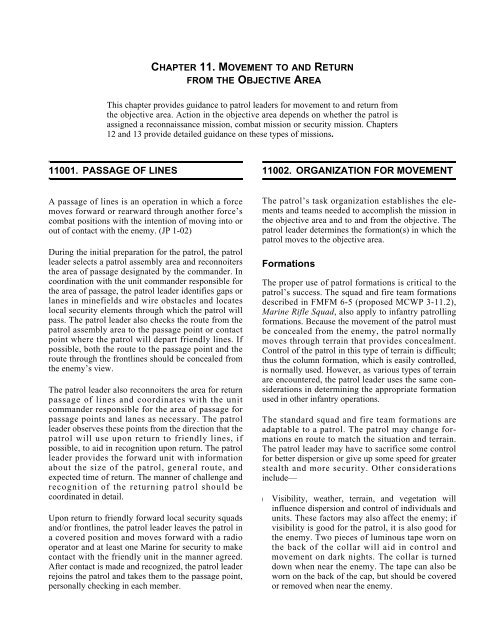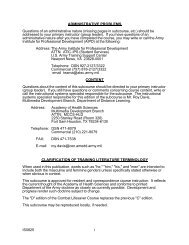MCWP-3-11.3-Scouting-and-Patrolling
MCWP-3-11.3-Scouting-and-Patrolling
MCWP-3-11.3-Scouting-and-Patrolling
Create successful ePaper yourself
Turn your PDF publications into a flip-book with our unique Google optimized e-Paper software.
CHAPTER 11. MOVEMENT TO AND RETURNFROM THE OBJECTIVE AREAThis chapter provides guidance to patrol leaders for movement to <strong>and</strong> return fromthe objective area. Action in the objective area depends on whether the patrol isassigned a reconnaissance mission, combat mission or security mission. Chapters12 <strong>and</strong> 13 provide detailed guidance on these types of missions.11001. PASSAGE OF LINES11002. ORGANIZATION FOR MOVEMENTA passage of lines is an operation in which a forcemoves forward or rearward through another force’scombat positions with the intention of moving into orout of contact with the enemy. (JP 1-02)During the initial preparation for the patrol, the patrolleader selects a patrol assembly area <strong>and</strong> reconnoitersthe area of passage designated by the comm<strong>and</strong>er. Incoordination with the unit comm<strong>and</strong>er responsible forthe area of passage, the patrol leader identifies gaps orlanes in minefields <strong>and</strong> wire obstacles <strong>and</strong> locateslocal security elements through which the patrol willpass. The patrol leader also checks the route from thepatrol assembly area to the passage point or contactpoint where the patrol will depart friendly lines. Ifpossible, both the route to the passage point <strong>and</strong> theroute through the frontlines should be concealed fromthe enemy’s view.The patrol leader also reconnoiters the area for returnpassage of lines <strong>and</strong> coordinates with the unitcomm<strong>and</strong>er responsible for the area of passage forpassage points <strong>and</strong> lanes as necessary. The patrolleader observes these points from the direction that thepatrol will use upon return to friendly lines, ifpossible, to aid in recognition upon return. The patrolleader provides the forward unit with informationabout the size of the patrol, general route, <strong>and</strong>expected time of return. The manner of challenge <strong>and</strong>recognition of the returning patrol should becoordinated in detail.Upon return to friendly forward local security squads<strong>and</strong>/or frontlines, the patrol leader leaves the patrol ina covered position <strong>and</strong> moves forward with a radiooperator <strong>and</strong> at least one Marine for security to makecontact with the friendly unit in the manner agreed.After contact is made <strong>and</strong> recognized, the patrol leaderrejoins the patrol <strong>and</strong> takes them to the passage point,personally checking in each member.The patrol’s task organization establishes the elements<strong>and</strong> teams needed to accomplish the mission inthe objective area <strong>and</strong> to <strong>and</strong> from the objective. Thepatrol leader determines the formation(s) in which thepatrol moves to the objective area.FormationsThe proper use of patrol formations is critical to thepatrol’s success. The squad <strong>and</strong> fire team formationsdescribed in FMFM 6-5 (proposed <strong>MCWP</strong> 3-11.2),Marine Rifle Squad, also apply to infantry patrollingformations. Because the movement of the patrol mustbe concealed from the enemy, the patrol normallymoves through terrain that provides concealment.Control of the patrol in this type of terrain is difficult;thus the column formation, which is easily controlled,is normally used. However, as various types of terrainare encountered, the patrol leader uses the same considerationsin determining the appropriate formationused in other infantry operations.The st<strong>and</strong>ard squad <strong>and</strong> fire team formations areadaptable to a patrol. The patrol may change formationsen route to match the situation <strong>and</strong> terrain.The patrol leader may have to sacrifice some controlfor better dispersion or give up some speed for greaterstealth <strong>and</strong> more security. Other considerationsinclude—l Visibility, weather, terrain, <strong>and</strong> vegetation willinfluence dispersion <strong>and</strong> control of individuals <strong>and</strong>units. These factors may also affect the enemy; ifvisibility is good for the patrol, it is also good forthe enemy. Two pieces of luminous tape worn onthe back of the collar will aid in control <strong>and</strong>movement on dark nights. The collar is turneddown when near the enemy. The tape can also beworn on the back of the cap, but should be coveredor removed when near the enemy.



